
| Return |
|
• July 29 The mystery of a comet seeker 5 I was using a 15cm reflector at my home observatory (MPC 370) in the 1950s. The population of Kochi City in those days was 180,000 and there wasn't much air pollution over the city. Actually the sky over Kochi was better than Geisei. Mt. Hitsuzan, well known in the area, is seen in the southeast from the observatory. To the right of Mt.Hitsuzan there are a series of low peaks such as Saragamine and Koishikiyama. Mysterious incidents began to occur around the end of the 1950s. Late-night fires became frequent in the vicinity of Saragamine where there shouldn't have been any source of fire. There was a possibility of fires being deliberately lit and the fire department and police were on the alert nightly. However, mysterious fires continued to break out, outwitting those on the watch. Later, fires broke out at more than two places simultaneously. It became possible that an experienced arsonist started fires using time device and seemed to be enjoying himself looking at fires from the distance. The culprit was never found and it went down in crime history as an unsolved mystery. There was a character who called himself "Jiro Soka" about 30 years ago. He succeeded in escaping from police by confusing their dragnet just like Arsene Lupin, the criminal character of Maurice Leblanc mystery. This arsonist seemed to be enjoying his criminal activity. "He gives police an advance warning. The police dragnet closes in on him. But they find no sign of the thief there. He has left evidence, as if ridiculing the police, of his presence and successful theft." The name Jiro Soka has disappeared forever after a large scale police search of his crime using the Bullet train failed. The series of fires by an arsonist reminds me of this bizarre crime which has been almost forgotten by now. Didn't anybody know of this arsonist? Early in December, when the yearend was just around the corner, I was searching, as always, the southeastern sky one hour before the dawn at the observatory, which had been set up at the yard of my residence. I found a flame suddenly rising from the mountain. The distance to the fire was 2 kilometers in a straight line from my observatory. Instinctively, I turned my comet seeker to the fire and saw the face of the man who seemed to be the culprit. His face was lit by blazing red flames! Immediately I increased the magnification to 200. I saw a middle-aged man in a light blue worker's overall with a soldier's field cap on. He appeared as a laborer or farmer. The man left the scene quickly after making sure the fire was going. (To be continued) |
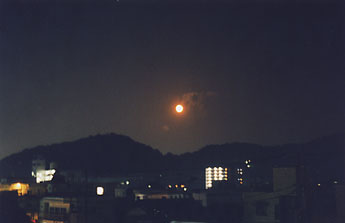 The moon over Mt. Hitsuzan from my home observatory (MPC 370) |
|
• July 22 A falling meteor? Kochi City was shaken! • July 12 Reminiscing about the mountains I visited the landing site of the "zaisho meteorite" at Kahokucho, Kamigun in Kochi Prefecture. It is at the foot of a low mountain immediately north of Monobe River. It landed in the yard of the farmhouse of a Mr. Arimitsu. The meteor landed approximately at 5:10 in the morning on February 1 in the 31st year of Meiji (1898). According to the local paper Doyo Shinbun, the ground and sky shook with the roaring sound which resembled a successive firing of a cannon. The sky turned a brilliant scarlet red as if fireworks had been launched and a round fireball, a size of a human head, was seen slowly falling. This is a scene witnessed at Funato, a village in the mountains near the border between Kochi and Ehime Prefectures, 40km north of the landing site. This ground-shaking roar was reported to be heard almost all over Kochi Prefecture and many people rushed out of their homes in their sleepwear. The meteor landing in Tosha City in the 28th year of Meiji (1895) occurred with an equally loud sound. The falling meteor seems to be quite a phenomenon accompanied by a lot of commotion. I stood at the landing site in Kahokucho. I almost felt the supernatural when I realized that a meteor actually had fallen to the ground where I was standing and it had traveled from a far-flung corner of the universe. The monument to commemorate the fall of the meteor was now looked after by Mr. Hiromi Arimitsu. It was erected by Mr. Saizo Goto, who owned the meteorite, around 1982. I was moved by a beautiful lily flowering quietly beside the silent monument for over 100 years It has become an occurrence of the long past that neither flowers nor people now know much about. But Monobe River running through the never-changing mountain ranges knows everything and I cannot help but feel the river was trying to tell me something. |
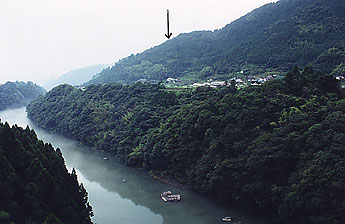 The meteor landed near the farmhouse at the foot of the mountain along Monobe River 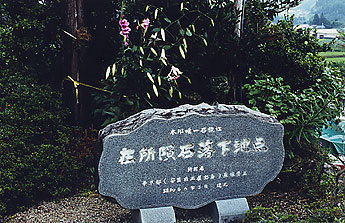 The monument at the landing site of the meteor (erected in 1981) |
|
• July 10 The mystery of a comet seeker 3 This is the day of Tanabata (Star) Festival. The forecast issued yesterday (June 6) was "cloudy, rain developing later", but it turned out to be wrong. Forecasting during the rainy season is often proved to be wrong. I went to the observatory and continued to observe under a clear sky until late. Stars were not supposed to be visible according to the forecast, but the Milky Way was seen, though for not long. Since then, on the days when "cloudy or rain" was forecast, we sometimes have had cloudless hot days. Forecasters are often wrong. Their judgment may be clouded by the assumption that it would be only natural to be cloudy because it is during the rainy season. I check the weather maps and satellite images of the day to make my own forecast before going to the observatory. I photographed Vega (one of the two stars of the Tanabata story) on the evening of Tanabata Festival. |
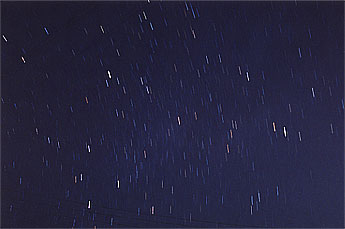 |
| • July 5 The mystery of a comet seeker 2 I visited Dodaira Observatory in Saitama Prefecture with Mr. Kaoru Ikeya in May 1966. Mr. Tomita, a staff member, showed us around. The sky conditions were excellent and the Milky Way near Scorpius in the southern sky was clearly seen. The Observatory's 91cm reflector had been very effective for detection of many periodic comets. It not only detected the highest number of periodic comets in Japan, but its achievements attracted the world attention. Another staff member, Mr.Kaho, was engaged in observing together with Mr. Tomita. They were actively involved in tracking of satellites with an American-made Baker-Nunn Schmidt Camera as part of the international observing network. I found a strange-looking instrument there. It was a finderscope. A 20cm-aperture refractor was mounted on the camera (at far right) serving as a guidescope. This was that mysterious Zeiss telescope. What sort of star images did this telescope form with a perfect triplet lens system. This telescope had been removed from the original mounting and was now playing a vital role as a guidescope for the schmidt camera. I had an opportunity to attend a lecture given by Mr. Kyoyu Kudara who recovered Comet Temple 2. He talked about the world's unusual comet seekers and referred to the Zeiss telescope concluding that it had probably been imposed on them when they purchased the 60cm refractor. A scientific magazine introduced this comet seeker around 1949 with detailed illustrations together with a report on a comet hunter who was using this telescope. (to be continued) |
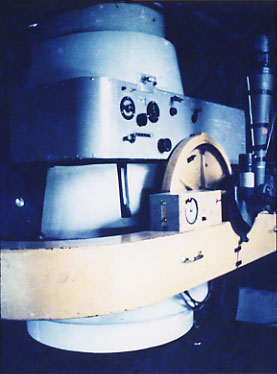 Zeiss 20cm comet seeker (far right) mounted as a guidescope on Baker-Nunn-Schmidt camera. |
Copyright (C) 2004 Tsutomu Seki.